#914 NGC 6826: The Blinking Eye December 19, 1997
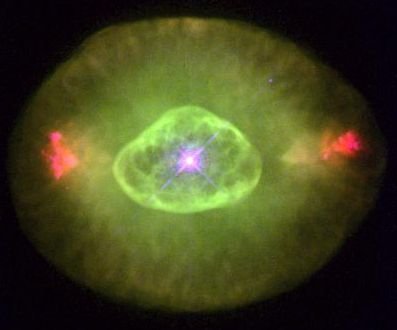
“The colorful planetary nebula phase of a sun-like star's life is brief. Almost in the "blink of an eye" - cosmically speaking - the star's outer layers are cast off, forming an expanding emission nebula. This nebula lasts perhaps 10 thousand years compared to a 10 billion year stellar life span. Spectacular planetary nebulae are familiar objects to both professional and amateur astronomers, but they still contain a few surprises. For instance, the lovely nebula NGC 6826, also known as the Blinking Eye Nebula, has mysterious red FLIERS seen on either side of the Hubble Space Telescope image above. Are they also expanding outward from the central star? If so, their "bow shocks" point in the wrong direction!"
Copyright: Public domain
#915 Apollo 16: Exploring Plum Crater December 20, 1997
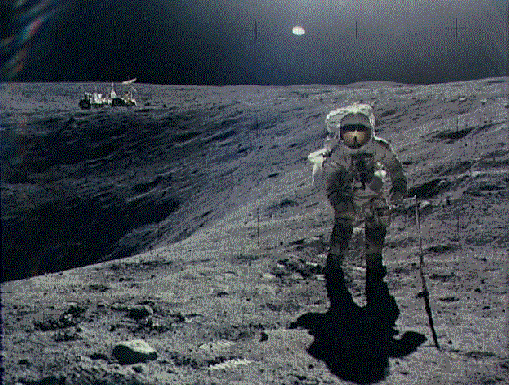
“Apollo 16 spent three days on Earth's Moon in April 1972. The fifth lunar landing mission out of six, Apollo 16 was famous for deploying and using an ultraviolet telescope as the first lunar observatory, and for collecting rocks and data on the mysterious lunar highlands. In the above picture, astronaut John W. Young photographs Charles M. Duke, Jr. collecting rock samples at the Descartes landing site. Duke stands by Plum Crater while the Lunar Roving Vehicle waits parked in the background. The Lunar Roving Vehicle allowed the astronauts to travel great distances to investigate surface features and collect rocks. High above, Thomas K. Mattingly orbits in the Command Module."
Copyright: Public domain
#916 A Winter Solstice December 21, 1997
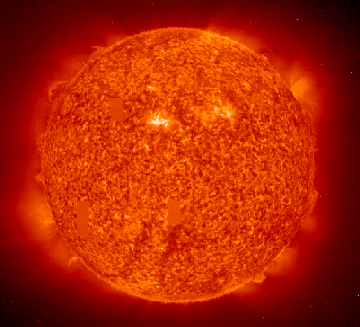
“Today is the Winter Solstice, the shortest day of the year in the Northern Hemisphere. The yearly cycle of Seasons on planet Earth once again finds the Sun at its lowest point in the Northern Sky. The Sun's own 11 year cycle of activity is progressing toward a maximum which will occur in 2000-2001. This image of the Sun in the light of ionized Helium was recorded by the space-based SOHO observatory only three days ago and shows many prominences and active regions."
Copyright: Public domain
#917 David N. Schramm 1945-1997 December 22, 1997

“David N. Schramm effectively combined the very big with the very small. Among his many scientific achievements, Schramm and collaborators successfully used Big Bang cosmology to predict that only three families of elementary particles exist in the universe, which was subsequently confirmed by high energy particle accelerators. Schramm and collaborators realized that current relative elemental abundance measurements, when combined with nuclear reaction rates, constrain the amount of normal matter to be much less than that implied by the movements of stars and galaxies. Therefore, most of the universe might be made of some sort of dark matter. Schramm was a champion wrestler, a mountain climber, an inspiration to scientists and students, and was alone piloting a plane when it crashed last Friday."
Copyright: Public domain
#918 M2-9: Wings of a Butterfly Nebula December 23, 1997
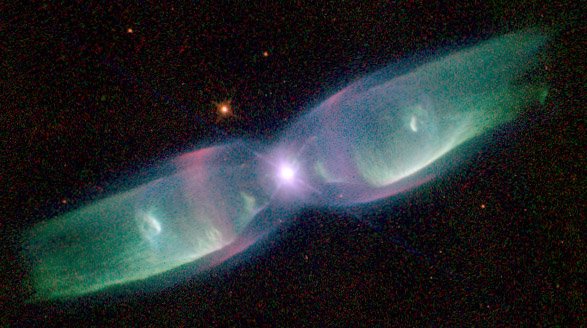
“Are stars better appreciated for their art after they die? Actually, stars usually create their most artistic displays as they die. In the case of low-mass stars like our Sun and M2-9 pictured above, the stars transform themselves from normal stars to white dwarfs by casting off their outer gaseous envelopes. The expended gas frequently forms an impressive display called a planetary nebula that fades gradually over thousand of years. M2-9, a butterfly planetary nebula 2100 light-years away shown in representative colors, has wings that tell a strange but incomplete tale. In the center, two stars orbit inside a gaseous disk 10 times the orbit of Pluto. The expelled envelope of the dying star breaks out from the disk creating the bipolar appearance. Much remains unknown about the physical processes that cause planetary nebulae."
Copyright: Public domain
#919 30 Doradus Across the Spectrum December 24, 1997
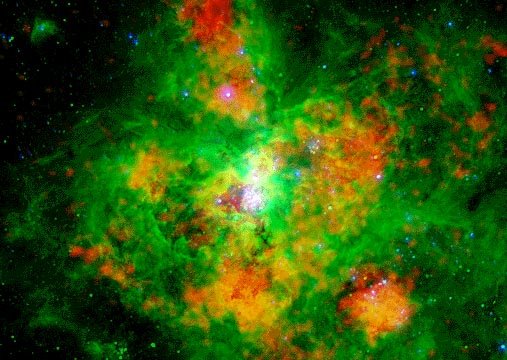
“30 Doradus is lit up like a Christmas tree. Shining in light across the electromagnetic spectrum, 30 Doradus glows because of all the energetic processes that go on there. A distinctive region visible in a Milky Way satellite galaxy called the Large Magellanic Cloud (LMC), 30 Doradus is a hotbed of star formation, supernova explosions, and ionized plasma. The above image is a composite of three pictures taken in three different wavelength bands of light. Red represents X-ray emission created by gas as hot as 1 million degrees Kelvin. Green represents emission from ionized hydrogen gas, and blue represents ultraviolet radiation primarily emitted by hot stars. At the conclusion of this symphony of star formation and light in a few million years, astronomers expect that a new globular cluster will have formed."
Copyright: Public domain
#920 A Hale-Bopp Holiday December 25, 1997
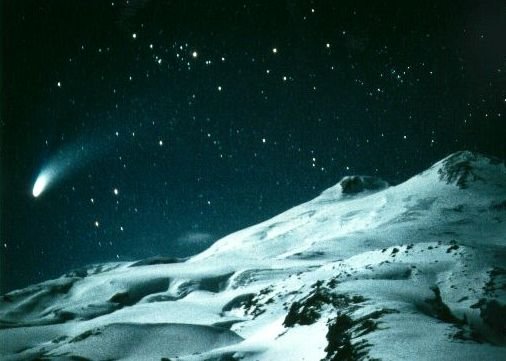
“Seen from the Pik Terskol Observatory in the northern Caucasus mountains, comet Hale-Bopp and the bright stars of the constellation Perseus hang above the snowy, moon-lit landscape. Although it reminds Northern Hemisphere dwellers of an idyllic Winter scene, this picture was actually recorded in the spring - on April 13th of this year. Seasons Greetings and Best Wishes from APOD!"
Copyright: T. Credner
#921 West Of The Great Red Spot December 26, 1997
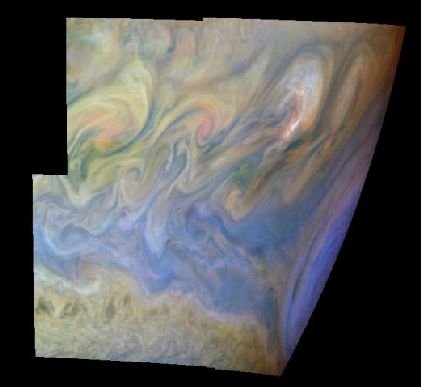
“The turbulent region West of Jupiter's Great Red Spot is highlighted in this recent picture constructed from data recorded by the Galileo spacecraft. The image is color coded to show cloud height and thickness; white clouds are high and thick, light blue clouds are high and thin, and reddish clouds are low. The edge of the Red Spot itself appears blue here (lower right) and spans about 6,600 miles along the curving limb of the planet (north is up). Westward winds, deflected north by the circulation within the Great Red Spot, collide with Eastward winds at higher latitudes and generate the roiling, turbulent structures. The largest eddies near the Northwestern edge of the Red Spot are bright, suggesting upward convection and high altitude cloud formation are taking place there."
Copyright: Public domain
Upvote! Resteem! Comment! As you like it! Thank you for attention!
Resteemed to over 6000 followers and 100% upvoted. Thank you for using my service!
Send 0.100 Steem or 0.100 Steem Dollar and the URL in the memo to use the bot.
Read here how the bot from Berlin works.
@resteem.bot
Downvoting a post can decrease pending rewards and make it less visible. Common reasons:
Submit